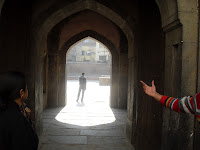Nizamuddin Basti Walk
This heritage walk to the basti was organized by the Aga Khan Trust for Culture.We all were supposed to gather at the Shiv Mandir, Hazrat Nizamuddin basti (near Lodhi crematoriWe were introduced to our guide Mohd. Umaer .He started with the history of Nizamuddin .He told us that the village got its name from the famous Sufi saint Sheikh Nizam-u-din Auliya of the chisti order and hence started our journey back to the 14th century
 The Phoolwali GaliWe went through this only surviving archway that once surrounded the settlement. It was made by Pir Inayat Khan further we went and saw the tombs of Pir Inayat Khan and his son Pir Vilayat Inayat Khan (which was done beautifully with marble mosaics)
The Phoolwali GaliWe went through this only surviving archway that once surrounded the settlement. It was made by Pir Inayat Khan further we went and saw the tombs of Pir Inayat Khan and his son Pir Vilayat Inayat Khan (which was done beautifully with marble mosaics)From here we moved further into the narrow lane to see the Kalan masjid, built by the Prime Minister Firoz Shah Tughlaq in 1387 AD. Here we had a glimpse of vazu and madarso and mihrab
- .Then our walk stopped at the Urs mahal. Our guide Mohd. Umaer explained us the meaning of urs and how it is performed
- Chausath Khamba



 It is a grand marble tomb of Muza Aziz Kokaltash – son of Atgah Khan and Jiji Anga built in 1623. One look at the monument we can count only 36 pillars unlikely to the name but on asking we came to know that on the side 4 pillars were joined together so it made 64 pillars in total. It has 25 bays, five on each side, each loofed with a dome inside but concrete outside. Aayaats of Quaran ran
It is a grand marble tomb of Muza Aziz Kokaltash – son of Atgah Khan and Jiji Anga built in 1623. One look at the monument we can count only 36 pillars unlikely to the name but on asking we came to know that on the side 4 pillars were joined together so it made 64 pillars in total. It has 25 bays, five on each side, each loofed with a dome inside but concrete outside. Aayaats of Quaran ran  Not far from here is the humble tomb of Mirza Ghahib- the 19th century Urdu poet. Mohd. Umaer told us that earlier it was just a marble slab with an inscription on it but the marble structure was built on the grave later. He also narrated a few interesting events of Gahibs lifetime.
Not far from here is the humble tomb of Mirza Ghahib- the 19th century Urdu poet. Mohd. Umaer told us that earlier it was just a marble slab with an inscription on it but the marble structure was built on the grave later. He also narrated a few interesting events of Gahibs lifetime. The Jama’at Khana Mosque is the oldest structure in the dargah complex. It has 3 bays each topped with the dome, the central being the highest.
Tomb of Jahanara is an open enclosure and the epitaph reads “let not cover my grave save the grass: for grass will suffice the covering of the grave.”
Tomb of Amir Khusrao –Amir Khusrao the disciple of Hazrat Nizamuddin Auliya has his tomb in the dargah. It has a vaulted roof on 12 pillars with lattice marble screen in between each pillar.
On our way back we also saw the Baoli built by the Hazrat Nizamuddin Auliya in 1321-1322.
On our return we thanked our guide and returned with good knowledge and satisfaction.






Wow, that is a good description of the walk and its monuments.
ReplyDeleteBiba u did a great job...!!! Thumbs up :)
ReplyDeleteRuby
Thanxs
ReplyDeleteSeems interesting walk, how much time it takes
ReplyDeleteit takes 2 to 2and a half hours
ReplyDelete